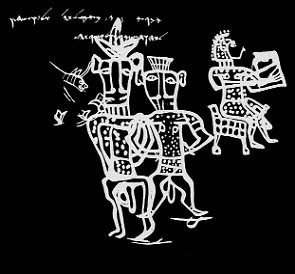In my youth, my father would perform an amusing rockette-like jig in his bathrobe whenever he’d be inspired to sing this song for me. One of the song lines refers to a certain Rivkeh as being a ‘favorite dish', as the singer looking forward to Shabbes, when ‘we’ll eat gefilte fish.’
Which is good segue to the discussion at hand. Fish on Shabbes was always an important part of the Yid’s diet. In the cities of antiquity however it wasn’t easy to buy fish in towns far away from a shore.
In late 2005, while digging in the remains of an ancient building in the City of David just south of the Old City wall, Israel Antiquities Authority archaeologists made a very interesting discovery.
In late 2005, while digging in the remains of an ancient building in the City of David just south of the Old City wall, Israel Antiquities Authority archaeologists made a very interesting discovery.
Careful sifting of the soil revealed a considerable quantity of animal bones. The bones of sheep, goat and cattle are routine discoveries but this sifting produced a substantial amount of fish bones. In Jerusalem, which is far from the sea and large rivers, the consumption of fish was not an insignificant matter.
The fish were identified by Professor Omri Lernau of the University of Haifa, a renowned expert on the subject. In a preliminary examination, he identified the following species of fish: Nile perch, which was imported from Egypt; mullet, sea bream and red drum, which were brought from the Mediterranean Sea and catfish from freshwater rivers.
Fish bones have already been found in buildings that date to the end of the Iron Age in previous excavations in the City of David. Now it seems that this fare, which in Jerusalem was most certainly considered a luxury, was served up on the residents’ tables already in the latter part of the 9th century and in the 8th century BCE.
This find is also associated with the name of one of the city’s gates during this period, the “Fish Gate”, which is mentioned several times in the Bible (Zephaniah 1:10; Nehemiah 3: 3; II Chron. 33; 14) and the local fish market probably existed nearby.

During the period of the Return to Zion (5th century BCE) Nehemiah, the governor of Judah, complained that the men of Tyre (Phoenician sailors) resided in Jerusalem and that they are the ones who brought the fish to the city and sold it to the residents of Jerusalem specifically on the Sabbath.
A few observations:
1) How was the fish kept fresh during the long Donkey ride up to Jerusalem? Maybe they only sold the fish in the winter.
2) What’s with the catfish? Catfish, treife catfish, eaten in ir hakoidesh during the first temple era! Wow! Might this be a piece of evidence that kosher laws were written by the Priestly source after the destruction of the first Temple, during the Babylonian exile?
3) Even after Shibat Tzion (return form the exile) many Jews bought fish on Shabbes from the Phoenician sailors.
And now to this week's issue of Today in the life of the Jews:

The death of Anacletus II, the ‘Jewish Pope’, in 1138. His great grandfather was a prosperous Jewish banker named Benedict, who became a goy for an aristocratic shidukh. The convert’s son and grandson, Leo and Piero Leoni, became prominent in Roman civic life. The latter decided to steer his son Piero Pierleoni to an (ultimately successful) clerical career fueled by his money and connections. Pierleoni would become a cardinal, then a papal legate in France, and finally ascend to the papacy (reportedly through bribes), taking the name Anacletus II upon the death of Honorius II (I presume you’ve been keeping up on your papal history). Many resented his raw use of money to fuel his career, not to mention his Jewish ancestry. He was widely derided as an antipope, and European royalty preferred his rival Innocent II. By lavishing his fellow Romans with gifts and parties, Anacletus II was able to retain the devotion of his paisans, and his day job. BTW -- unlike other meshumads, he was friendly to the Jews.

6 comments:
By the way it's funny that in Israel gefilte fish is the butt of not a few anti-ashkenazi jokes. I once read that Bedouins (of all people..) in Israel's Negev have grown quite fond of this dish and order large quantities of it to break their Ramadan fast.
truly hillarious janitor. chinese people also love gefilte fish. BTW -- my grandmother on my litvak (israeli) side used to refer to it as gakahteh fish
About the catfish: Nice try, Apikores, trying to suggest that the permitted and forbidden foods were not instituted until later, but it is much more likely that the same Israelites who went whoring after idolatrous cults probably indulged themselves in forbidden foods.
goyish: first of all thanks for the reuel comment; i realized that but life being what it is i forgot to return and correct it. in any case, it makes no difference. I find it very interesting that yitro had seven names. lots of traditions.
about the catfish: how do you know its more likely? as is, it appears (archeologically)that local israelite folk religion was polytheistic, and pretty similar to the neighboring nations to the north and east. the strict monotheistic culture as described in, say, vayikra was nothing like what really existed. i believe that the priestly school wrote vayikra (and codified the kosher laws)years post bayit rishon.
thanks for visiting rebbe, come again soon.
awesome blog, do you have twitter or facebook? i will bookmark this page thanks. lina holzbauer
Post a Comment